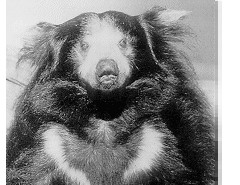
 Sloth Bear Watching |
Melursus ursinus
Aswail
|
The sloth bear is relatively small, with long hair and shaggy coat. The bear is often black, but reddish animals have been seen. The nostrils of the muzzle can be closed at will, possibly as an adaptation to the defenses of the termites which make up a large portion of their diet. Their dark fur is often interspersed with whitish or greyish strands, and they display a noticable whiteish or cream-colored U shaped patch on their chest. Behind their heads, they have a mane, a ruff of fur that covers their neck and part of their shoulders. Their belly and underlegs are nearly bare. The sloth bear's ears are large and floppy; they have very good hearing. The claws of the sloth bear are sickle-shaped, and deeply curved.
The sloth bear is unique among bears as it has only 40 adult teeth. The cubs have 42 while nursing. The two middle, upper incisors do not grow in with the rest of the permanent teeth. The dirt that the bears ingest with their food often leads to bad teeth, as it grinds away the enamel. When feeding, the bears make loud, sucking sounds which can be heard for many miles.
Sloth bear adults can weigh anywhere from 120-310 pounds and measure anywhere from 60-75 inches in length. The males are larger than the females.
Sloth bears are found in the forested areas and grasslands of India and Sri Lanka. However, the bears have also been witnessed in Nepal, Bangladesh, and Bhutan.
Sloth bears live a solitary existance, except when raising young or mating. The bears have a number of vocalizations, but their purpose is not understood.
Reproduction for the sloth bears is a fairly standard affar. The animals breed
in late Spring/early Summer, with the cubs being born six to seven months later.
Like other bears, the litters are small, consisting of only a cub or two. Very
rarely, sloth bears have been reported as having three. The cubs stay in their
mother's earth den for the first two to three months, they will continue to stay
with their mother through their adolescence, which lasts approximately 2 years.
![]()